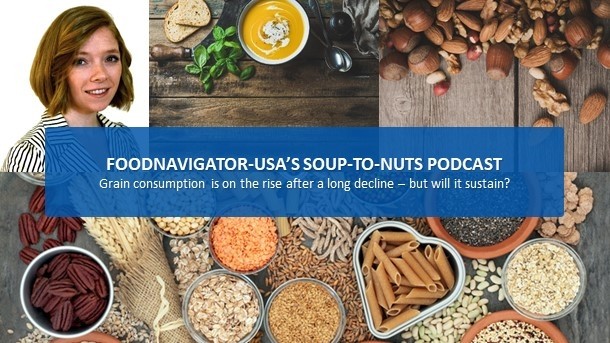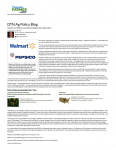Soup-To-Nuts Podcast: Grain consumption is up – but will the momentum sustain post-pandemic?

According to data published by the Economic Research Service of the US Department of Agriculture, per capita flour consumption in 2019 fell 2.1 pounds or 1.5% to 130.7 pounds from 132.8 pounds in 2018. This was down a whopping 11% from the most recent high of 146.8 pounds in 1997 and the lowest since 1989 when consumption was only 129.1 pounds.
But according to Christine Cochran, executive director of the Grain Foods Foundation, consumer views and consumption of flour and other grains have reversed course during the pandemic – a trend she predicts will continue going forward. In this episode of FoodNavigator-USA’s Soup-To-Nuts podcast, Cochran explains what is behind the ups and downs of grain consumption in the US, how the pandemic has reshaped consumers’ approach to and perception of grains, where there is whitespace for innovation, and how the Grain Foods Foundation will continue to build on this positive momentum going forward.
[Editor’s note: Never miss another episode of FoodNavigator-USA’s Soup-To-Nuts podcast – subscribe today.]
Reversing decades of decline
For decades, grains and carbs have been demonized as contributing to weight gain or slowing weight loss efforts, but Cochran says that as the pandemic pushed many consumers to reconsider the role of diet and wellness they began to take a more balanced, holistic approach to nutrition, which opened the door for grains to play a more prominent role in a healthy lifestyle.
“We’ve been tracking a couple of numbers for decades now, and one of them is called the flour disappearance rate on a per capita basis… and what we’ve seen is, over the last decade that number has been in fairly steady decline,” Cochran said. “And then when you go and look at the heart of the category, which is bread sold in grocery stores … we’ve also seen an even more dramatic decline in consumption going into 2018 an the preceding 10 years.”
She attributes the decline to “anti-carbohydrate” language, which while not new “reached a volume in 2018 and 2019 that was just exceptionally loud.”
But at the same time in 2018 and 2019, conversations around diet started to move beyond the vanity of weight loss and demonizing individual ingredients or nutrients to take a more holistic approach, which allowed consumers to incorporate grains into their diets in a healthy, balanced way.
The pandemic accelerated this trend and also gave way to mental wellness, including comfort and togetherness, to be considered in healthy dietary choices – further fueling the rise of grains again, Cochran said, noting that research commissioned by GFF found most consumers characterized bread and pastas a both comforting and nutritious.
Grain-based foods also saw an uptick during the pandemic because they were accessible and budget-friendly, which became more important as unemployment sky rocketed and consumers looked for ways to stretch premium ingredients while still meeting dietary needs.
The pandemic’s long-term impact on grocery carts
While some of the trends that boosted grain consumption in 2020 likely will not survive beyond the pandemic – like the sourdough craze or scratch-baking everything, everyday – Cochran said the experiences and values consumers gained from those experiences opened their minds to grains in new ways and will influence their grocery carts going forward.
“I do not believe America is a country of scratch bakers – those days are long gone. However, I do think that the memory of” baking more during the pandemic “will live for a long time. So, while people might not be making sourdough bread every day or every week moving forward, I think its something that they’re going to continue to do. I think they might think about keeping that flour on the shelf for when they want to do it now that they know how.”
Supply chain constraints early in the pandemic also prompted some consumers to try unfamiliar or ancient grains. And as they learned new cooking techniques and recipes, Cochran believes these ingredients may work their way into some consumers’ shopping lists long-term.
Shifting shopping habits during the pandemic also revealed areas ripe for innovation, including co-marketing or packaging to showcase new or more convenient uses for grains, their role in plant-based and flexitarian diets and permissible indulgence.
Preventing a backslide with a Checkoff campaign
As economies reopen and consumer mobility returns, the Grain Foods Foundation is proactively protecting against a “backslide” in grain consumption by pushing forward a Checkoff initiative that would help raise awareness for the industry as a whole through marketing and consumer outreach.
“I’m optimistic that as an industry we’re going to step up, we are going to market for ourselves as a category and talk about the goodness of grain based foods,” Cochran said.
She explained that the industry is in the process of deliberating a Checkoff Initiative, which could be submitted as a final proposal to USDA as soon as this summer or fall. If finalized, Cochran said, the initiative would be “a tremendous tool for our industry.”
The Grain Foods Foundation also is trying to change consumers’ negative perceptions of grains by investing in science and research, including a recently published study in the peer-reviewed Current Developments in Nutrition that explores the benefits of refined grains and the risks of excluding grains from the diet.
In addition, it is working with food service and retailers to more prominently display grains.
Through this multi-prong approach, industry innovation and deeper consumer understanding of the value of grains, Cochran said the grain foods industry can sustain and build on the seeds of consumer interested in grains planted during the pandemic to help sales and consumption flourish going forward.


















